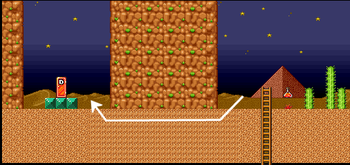Locks and Secrets
It's a secret to everybody. At least, that's how we try to make it. Back before I was even in grade school, I remember playing SMB and SMB3 as a group. All the kids would take turns playing, and in between turns sharing every secret we could remember. We had no concept of spoiling the experience for we were all youngsters putting our limited focus and motor skills together.
Super Mario Bros. showed the world how to make and hide secrets so many years ago. Since then more 2D Mario platformers have been released each with secrets of their own. Designing secrets is very tricky. The nature of many secrets is a test in player knowledge. Once you know that the fourth pipe from the beginning is a secret passage to a bonus room in SMB 1-1, that particular secret becomes less surprising and more routine for future play. Once the secret is out that pipes can be secret doors to room with wonderful coins, won't the player simply test every pipe in the game? The answer is no. And understanding why is quite complicated.
Finding a secret is initially about stumbling upon one or being told about its whereabouts. And for secrets that are repeated throughout a game, continually making a secret secret is all about manipulating player expectation. It's a classic exercise in theme and variation, or working with a limited set of elements and figuring out how to continually make the old new.
Like every other topic in this series or subject on this blog, we must start by breaking things down into types, categories, or levels.
Video game secrets fall into one of these types.
- Abstract, coded secrets. These are secrets that you'll rarely find on your own no matter how hard you try. Even if you manage to stumble across one, chances are you won't be able to reproduce the complex sequence of steps to ever do it again. For these secrets, the easiest way to experience them is to look them up. If you've ever held down on the white blocks in SMB3, run behind the scenery, and found the secret room behind the level end, you've experienced an abstract secret.
- Clued/cued secrets. These secrets are easy to spot. A ?-block in Mario or a treasure chest in Zelda hides something, but you don't know what it is until you investigate.
- Look-alikes. The developers have the power to make an object look like one thing and act like something else. In a medium where the visuals communicates the majority of crucial information the player needs to make informed strategic decisions, look-alikes will continually fool us. All bricks that look like bricks but actually hold coins or powerups fall in this category. Any given pipe can be an obstacle or a passageway. You never know until you investigate.
- Emergent/Organic secrets. Some secrets are well hidden from the player view. To uncover them players must use the any number or combination of mechanics in just the right way. Initially, these secrets may seem as difficult to discover as abstract or coded secrets. Keep in mind that the main difference is that the player is much more likely to stumble upon these secrets by merely playing the game. All invisible coin blocks are organic secrets. If you play enough, even if you attempt to play the same way through a level, small changes in your timing and behavior will make you more likely to find one of these secrets. As long as you can stumble into a secret from normal play (however you define normal play) and the secret doesn't have any visual, audio, or tactile cues, then it falls into this category.

This is the game that of course started it all off. Hopefully by now you realize that even though this game is an early NES title, every facet of its design is very well developed. Let's look at World 1-1.

- 2. clued) 13 ?-blocks
- 3. look-alike) 1 warp pipe, 1 10-coin brick, 1 star brick
- 4. emergent) 1 invisible 1up Mushroom block
In the first level of the game there are many secrets that reward the player in a variety of ways (coins, level short cuts, and powerups). But it's not enough to simply count the number of secrets in a level or game. We must look at how these secrets are hidden or implemented to throw off what the player expects. So, in 1-1 there are 30 bricks and 6 pipes total. This gives finding one of the brick look-alike secrets low odds.
With look-alikes and invisible blocks, SMB has more than enough room to continually throw you off your game to surprise you with a secret. But using variation of level elements is only the beginning. Mario has proved that one of the best places to hide secrets is within or underneath another secret. Let's look at World 1-2.

Most of 1-2 is composed of bricks. This design already gives discovering a brick look-alike secret extremely low odds. Notice how 2 of the 3 brick powerups can only be accessed after breaking the bricks beneath them with Super Mario. In other words these secrets are locked away so that only the Super Mario JUMP key can unlock them. This design adds a layer to the secret that makes the odds even larger. After all, if Small Mario can't break the bricks, players are forced to move on without testing bricks for their potential secrets. The more a player passes these areas without being able to test for secrets, the more experiences they build thinking that there's nothing out of the ordinary.
The first pipe in 1-2 takes players down into a bonus room. From the look of the room, players are free to grab the coins and get out. As you can see the last brick above the exit pipe is a secret coin-brick. The design of the bonus room in 1-1 has no secrets. So players might develop an expectation that bonus rooms are pretty straight forward. What you see is what you expect. This possible expectation makes the secret coin brick in the bonus room in 1-2 that much more effective.
When we play SMB now, we hardly think twice about using Super Mario to bust up through the roof of 1-2 and run around where the score is displayed. But if you can think back to when you first experienced 1-2 (or if you have imagine that's cool too), it's probable that you eventually beat the level without ever looking closely at the top of the screen. If nobody tells you that you can break through the roof, you might play through 1-2 many times without ever considering it. As your skills increase and you become more comfortable transforming/destroying bricks as Super Mario, you might look up at the roof and wonder of those bricks can be smashed too. Eventually you might make it up there and laugh at how the game didn't freeze and how you can just skip over the level. This is a neat experience and a reward in itself. When you get to the end of the road and you see the exit pipe, you might assume that you reached the only exit to the level unaware that if you continued traveling on top you would find warp pipes to other worlds. The large gap filled with moving platforms is what helps hide the warp pipe room secret within another secret. Every play experience builds expectations that can help conceal secrets from the player.
Secrets are a layer of game design that depends on a careful balance. Put too many secrets in a game, and they all become less significant and run the risk of making the game more about finding secrets than platforming. Fortunately, to help distract the player from discovering secrets there's the core game of SMB. The layers of mechanics, structures, enemies, and coins are more prominent and obvious thus occupying much of the player's attention. Ignore enemies and it'll soon be gameover. Dawdle too long, and the time limit will take your life. These elements of contrary motion and tension work well to keep the player moving.
The designers of SMB had to balance secrets within a level and between levels. If there are levels with many secrets then there must be levels with very few. Right after 1-1 and 1-2 there's 1-3, a level with only 1 ?-block and no other secrets. Enjoy focusing on platforming for a bit. Also in 1-4 there's only 1 ?-block and 6 invisible coin blocks. 2-2 has no secrets whatsoever.

SMB:LL's secret design extends the formula from SMB. By extending the secret design ideas from SMB, the developers created new ways to surprise even well seasoned SMB players. This was a particularly difficult thing to do considering SMB:LL shares many most of its assets with SMB. For an excellent example of hiding secrets within secrets and designing around player expectations, look at World 1-1 and 1-2 in SMB:LL.
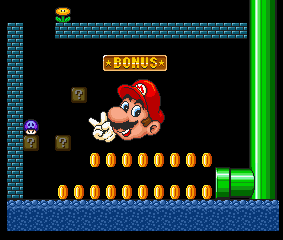
The bonus room in 1-1 is simple, yet the invisible blocks can lead up to secret brick powerup and/or unleash a Poison Mushroom. World 1-2 is an underground level in classic form. But instead of 1 normal exit and 1 secret exit, SMB:LL has 1 normal exit and 3 secret exits one of which is hidden within a secret path of another exit.
For the first and last time for the 2D Mario series, SMB:LL features secrets that are more like pranks than anything else. Playing off the players experiences that were built up playing SMB, SMB:LL punishes players for exploring certain pipes. One of the pipes in World 8-1 takes players to a warp pipe to World 5. Why would anyone ever want to go back in worlds? Instead of giving players a safe way out, the only options are to warp or die to reset the level. It's twisted.

With less secrets (total number) and less ways to mix up player expectation (fewer look-alike and invisible secrets), the secret design of SMB2 isn't as developed as SMB. What's worth noting is that SMB2 introduces 3 new types of secrets; player locked (only be accessible using a specific character), secrets hidden beyond dangerous zones, and a new type of secret within a secret.
Character Locks
- Skipping most of the level in 4-3 by flying from door B to door F is a neat secret that is hidden off the screen view and is only accessible with Peach. Getting the 1up on 5-1 is a lock that only Peach can crack with her special floating ability. The potion and warp on top of the entrance to 5-3 can only be accessed with Luigi.
Embrace Danger and Curiosity
- Secrets like in 3-1 and 6-3 are cleverly concealed behind the fear of danger and the unknown. In each example, the player must embrace a risky situation to reach the reward. 3-1 is also an emergent secret that can be stumbled upon if a player misses a JUMP and falls down the waterfall. And in 6-3 players have to avoid sinking into the sand pit at the entrance by repeatedly JUMPing to reach the other side (see image above).
Suspension To Hide Secrets Within Secrets
- The warps in SMB2 are like warp pipes from SMB, but in SMB2 they're hidden within the secret mirror world that can only be accessed with potions. There are only 4 warps in the game. Some warp spots are far away from where the potions are hidden. Players have to put two and two together by carrying the potion to the specific warp spot. This design takes advantage of the suspension of carrying objects from one area to another.

SMB3 takes the SMB and SMB2 secret design and expands on them.
Secrets within Secrets within Secrets.
- Double Warp Whistle. This is one of the most famous secrets within a secret in Mario history. Each warp whistle is very rare, and finding each is a secret within itself. Using the whistle takes players to the secret warp world. But, if players use another whistle in this special warp world, they can warp straight from world 1 to world 8.
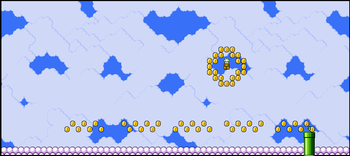
- In some secret bonus stages, there are additional secrets hidden in places Mario can only access by flying. In the example above, there are extra coins and a 1up-mushroom brick. (1-3)
- Just when you think the hidden vine in 3-7 is only designed to take you up to the area to the the left, there's another area to the right with another secret.
- In 4-1's hidden sky lake there's a secret warp pipe. In the pipe there are secret 1up Mushroom bricks.
Abstract Secrets
- DUCKing on the white block in 1-1 or 1-3 allows Mario to run behind the scenery and access secret areas at the end of the level. This secret is very abstract.
- Getting 44 coins or more in 1-4 or 3-8 yields a white mushroom house. Likewise, collect 22 coins in 4-2 and 28 coins in 5-5. These are the only levels in the game that have a secret coin collecting bonus. If nobody told you that this secret existed, then you'd probably never find it or figure out the exact coin requirements.
- In 1-Fortress, the hidden door C isn't ever visible on the screen. Even if you use Raccoon Mario to fly up to this secret area, unless you think to run all the way to the end and hit up, you won't discover the real secret. Because of the obscure door, this secret falls into the abstract category.
Locks & Keys
Locks that require powerups to unlock are not a new concept to the Mario games. There are many secrets in SMB that require Super Mario to break bricks for. Just look at SMB 1-2 for examples. However, with new powerups comes new opportunities to expand the types of powerup keys.
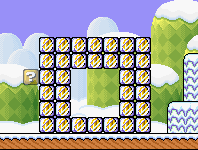
- Some elements are locked away in ice. Only a fireball from fire Mario can free the contents (see image above).
- In 2-4, you can use Raccoon Mario to fly up the left side of the stage. This level is like two levels stacked on top of each other. The bottom level contains enemies and pits, while the top level features many coins and a lake to play in. The more privileged level belongs to those with power.
- In 3-5 Use Frog Mario's enhanced swimming ability to swim against the pipe current and reach a secret bonus room.
- 3-5 features 2 10-coin bricks at the very top of the level. Players must exit the water and fly around to reach them.
- 5-Fortress features another area that can only be access as a flying Mario.
- In 5-5 players must use a Koopa shell or a Raccoon Tail whack to destroy 2 bricks from the side and access a pipe.
- To simply exit 6-5 you must have to continually loop through the stage until you become Racoon Mario. Then you have to grab a Koopa shell, fly up to a hidden area, and kick the shell into the "playground" there. That's 2 locks in 1 challenge.
- In 7-2 if you manage to get 46 coins or more and beat the level you will unlock a white mushroom house. This feat is locked away organically. Most of the coins on this level are underground silver coins. This means the player has a limited amount of time to grab them all. This already difficult task is made impossible because of the underground water. However, if you're Frog Mario the increased swimming ability will give you the edge you need to be successful.
Embrace Danger and Curiosity
- In 3-1, the first full water level in the game, players who are used to the water levels of SMB will most likely skip the secret at the very beginning of the level. After all, such players are used to the idea that going too far down in a water level is death.
- In 3-3 after reaching the exit pipe, go beyond risking attack from the big red Boss Bass to find a small island with a 1up Mushroom brick.

Much of the focus for SMW's secrets was put into secret exits. Each exit unlocks new ways to move on the world map and often times new levels. Alternate exits and warps are nothing new to the Mario series. To keep things fresh the designers hid away many exits in alternate paths and restricted behind locks that require powerup keys.
When In Doubt, Just FLY Out.
The following is a list of the secret exits that can be accessed with the power of flight. Notice how this category represents the majority of secret exit types.
- Donut Plains 1 (or use the green switch blocks)
- Donut Plains 2 (or take the vine)
- Donut Ghost House
- Donut Secret House (or take the vine)
- Vanilla Secret 1 (Fly up with blue Yoshi or use the blue switch blocks)
- Cheese Bridge Area (or sacrifice Yoshi for the double jump)
- Forests of Illusions 1 (use P-balloon to fly over to the key hole)
- Forest of Illusions 4 (or access the high pipe by JUMPing off the Koopa or double JUMPing off Yoshi)
- Chocolate Island 3. Fly up over the goal.
- Star Road 3. (or use the Lakitu Cloud)
- Star Road 5. Fly with blue Yoshi or unlock all the "!" switches.
Suspension
- Donut Secret 1. Carry the P-switch to a special spot.
- Vanilla Dome 1 requires the red switch.
- Vanilla Dome 2. Carry the P-switch, avoid the obvious, journey back to the right spot.
- Valley Ghost House. Carry the P-switch and make a stair case out of a special coin block.
Look-alikes
- Forest of Illusions 2. The wall in the water is not really a wall.
Powerup Keys (other than FLYing)
- Forest of Illusions 3. Use big Mario to SPIN JUMP through bricks and access the key and key hole.
- Valley of Bowser 4. Use Yoshi to lick up a key.
Abstract Keys
- Chocolate Island 2. Get through the first 2 screens in 50 seconds or less. This secret is very abstract, but at least the information speaker box gives players a hint.
Run On The Roof SMB 1-2 Style
- Valley of Bowser 2
Embrace Danger and Curiosity
- Star Road 2. Swim under part of the level to reach a new area.

NSMB takes elements of the secret design of all of its predecessors. It has invisible blocks. Passageway pipes. Dangerous sand and water paths. Secrets within secrets. Suspension based secrets. Powerup keys. Abstract secrets. And secret exits. Though not as many as SMW, in NSMB only 18 levels have alternate exits. To cover them briefly I made this list.

- 2-Castle and 5-Castle. Players must beat the boss as Mini Mario to take the alternate exit in the following cut scene (see image above).
- The secret exit in 1-2 is the classic SMB 1-2 run on the roof of the level secret.
- 1-Tower has a secret exit within a side room. In the secret area, only Shell Mario can break through the brick barrier and find the alternate ending flag pole.
- 2-A, players must either suspend a spinning spring pad from one area to another and rebound off of a red Koopa, or use Mini Mario to bounce up to the alternate exit passageway.
- 2-4 There's small pipe that only Mini Mario can access.
- 3-Ghost House. To spot the new door that appears, players must pay close attention. Looking past the obvious path, the door to the alternate exit becomes clear.
- 4-1 An invisible vine block leads the way.
- 4-Ghost House. Avoid the obvious path and use Mini Mario to leap for a hidden area. This area is hinted at by the star coin that can be seen later in the level.
- 5-2 Embrace the dangerous and enter a ceiling pipe that contains a Piranha plant.
- 5-B Seek out the alternate path that you can see in an earlier part of the level. To get there, you must travel on the roof SMB 1-2 style. To get past the brick barrier, Shell Mario is required.
- 5-Ghost House. This secret area can be seen from the normal path. To access it, players must hit invisible blocks to get high enough to hit the invisible vine block. Unlike every other invisible block in the Mario series, this one must be DUCK-JUMPed to activate because of how close it is positioned to the other blocks. Climb up, let the enemy destroy the bricks for you, and you're practically there.
- 7-Ghost House. By embracing danger and feeding your curiosity, you might notice a shiny brick in a particular time sensitive section of this ghost house. Hit the brick and a vine comes out. The rest is easy.
- 7-4 Mini Mario is required to access this alternate exit. The small pipe hints at this fact. Explore the area off to the side of the normal path.
- 7-5. Carry Bob-ombs from other parts of the level to blow open access to this pipe. If you have a Mega Mushroom, you can just smash your way through the barrier.
- 7-6 This alternate exit is reached with a vine. However, to clear the way for the vine, players need to be Super Mario size to break open a path.
Other secrets include...
- Finishing a level with the time as X11, x22, and so on. 1-3 yields a Mushroom House. 4-6 a 1up Mushroom house. 7-9 Mega Mushroom house.
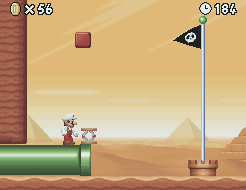
- Reaching the top of the flag pole in NSMB is a unique kind of challenge in and of itself. Like in SMB, some endings are simply a platforming challenge (though with much more variety in NSMB). Other endings are more like puzzles. Assuming that you can get to the top of every pole in the game, one must figure out what pieces of the challenge are missing to reach he top. Sometimes there are invisible blocks. Other times, springs, moving enemies, or platforms. In the image above, I had to use the spring to hit the invisible block. From there victory was simply a WALL JUMP and JUMP away.
The main focus of NSMB's secret design is no secret at all. Star coins are optional special coins that are set up to challenge the player in a variety of ways. Some are found easily, some can only be unlocked with specific powerups, and others are hidden in secret areas. I've organize the star coin challenges from nearly every level in the game into 3 groups. Results below.
Star Coins
- Easily found on the normal path. 159
- Powerup Locked. 20
- Secret Area. 54
My favorite Star Coins in NSMB.
- 1-4 star coin 2. Avoiding the obvious. Don't grab the coins as you move through the bonus room for you'll need them to reach the star coin after hitting the P-switch.
- 2-4 star coin 2. Embrace danger and curiosity. Avoid the obvious by not hitting the P-switch before you explore the area. Grab the star coin fist and then hit the switch to escape.
- 2-5 star coin 3. Embrace danger and curiosity. Sink into the sand to reach the hidden area that's hinted at later.
- 3-Castle star coin 2 & 5-Castle star coin 3. Run on the roof SMB 1-2 style.
- 6-3 star coin 3. Layered challenge. Use a mega mushroom to crush through the pipes or use some tight platforming skills to jump over it from the right side.
- 6-5 star coin 3. Embrace danger by getting sucked into a whirlpool.
- 8-T star coin 2. Layered challenge. To reach this coin you can slide as Super Mario. RUN as small Mario. WALL JUMP as Mini Mario. Shell Dash as Shell Mario.

The secret design of NSMBWii is the same as NSMB. Reaching the flag pole at specific times yields mushroom houses. Star coins are hidden throughout each level. And there are plenty of look-alike secrets like bricks and pipes.
One new feature NSMBWii adds to the look alike design is see through surfaces. Like special caves and coves from SMW2:Yoshi's Island, only after stepping into these areas can you see what's inside. While SMW2:YI reveals the whole areas after stepping inside, NSMBWii only reveals a small circular view holes.
I'm still working through all the secrets in NSMBWii so bear with me. Because NSMBWii shares its design most closely to NSMB, I know that it features a wide variety of secrets as well. In fact, all the Mario games (with the exception of SMB2) feature many secrets that are designed with lot of variety and/or well developed with the player's expectations in mind.
Before I wrap up this series, I want to finish talking about layers by covering NSMBWii's co-op and (p)layered design.
